 Full
FullGuide »
INTEGRATED PEST MANAGEMENT – APHIDS AND VIRUSES IN PULSES AND VEGETABLE LEGUMES
THE PROBLEM
Attacks by aphids may result in loss of yield by flower spoilage, failure of pods to fill and reduction of plant efficiency. Aphids transmit viruses and produce honeydew, an ideal medium for colonisation by saprophytic fungi, in particular the sooty moulds, and Botrytis spp. In addition, honeydew is very sticky and can lead to increased costs through the necessity for frequent washing down of vining machinery.
The pea aphid (Acyrthosiphon pisum) is green in colour with a pear-shaped body, long legs, and long antennae. There are both winged and wingless forms, the winged females being 2.5 – 3.0 mm long with deep red or black eyes, while the wingless females are of similar form but have a smooth, shiny outer skin.
Colonies form quickly, smothering the plant, as the female needs no male for fertilisation (parthenogenesis), and bears living young (viviparous) at a rate of 15 per day in suitable conditions. There are several generations in the pea aphid life cycle. Eggs over-winter on forage crops such as lucerne and clover, hatching in the spring to give wingless stem mothers. These produce spring colonies of wingless females, which in turn produce winged females that move into the crop in summer. These migrants produce the colonies that damage the crop. As the pea plants deteriorate the colonies produce winged female migrants that move to other plants to produce new colonies. Later in the season winged females move to over-wintering host plants where they produce males and females that lay eggs on the winter hosts. Adults may survive on winter hosts in mild winters.
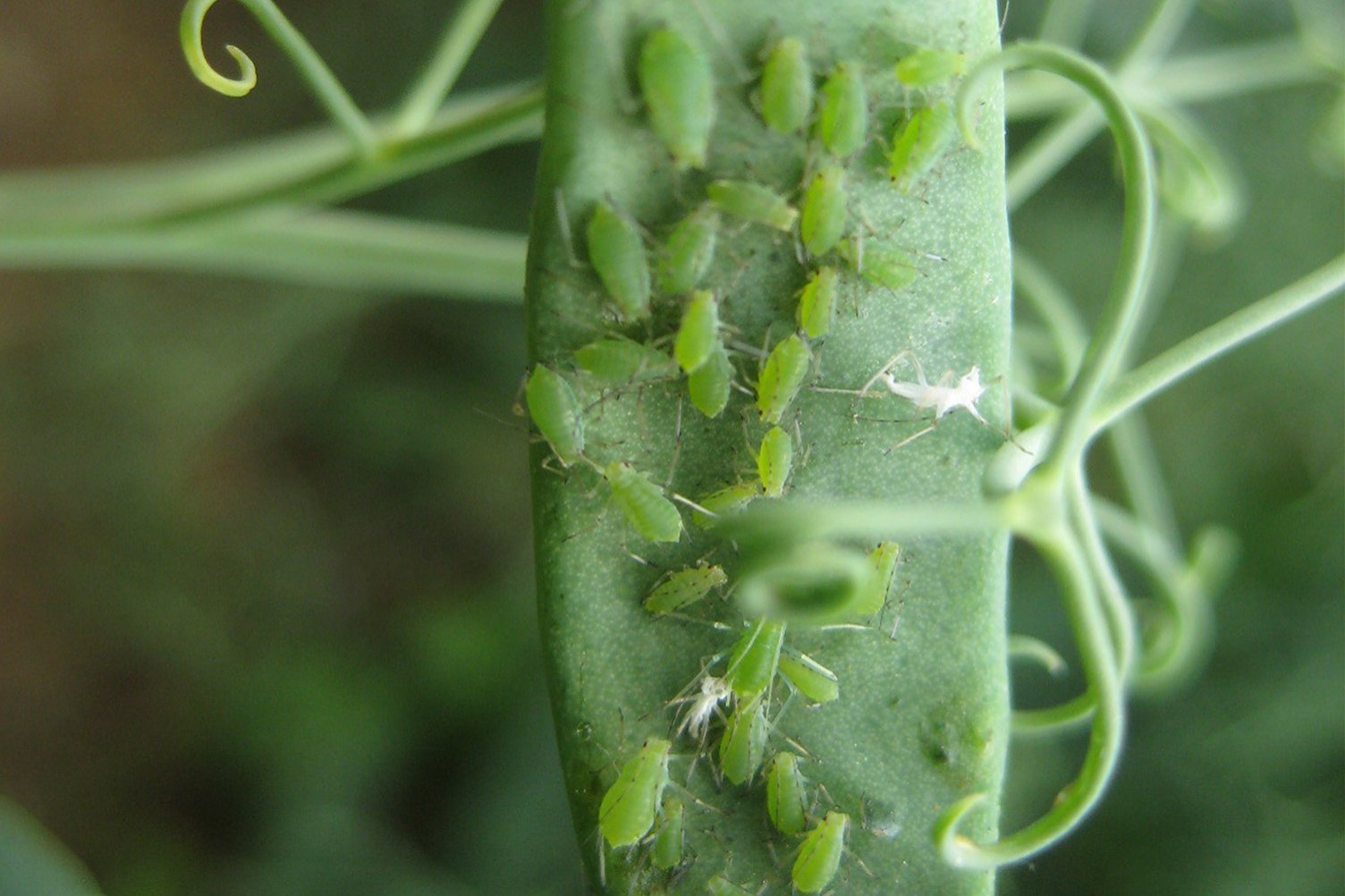 Pea aphid colony on pod.
Pea aphid colony on pod.
Black bean aphid (Aphis fabae)
Dense colonies of black aphids can develop at any time on the upper part of faba bean stems from the onset of flowering. The colonies can consist of hundreds of aphids which gradually extend downwards onto the leaves and developing pods. At first, individual plants may be infested and later the aphids spread into localised patches of infested crop.
Damage to bean crops occurs mainly as the direct effect of aphids feeding. Plants fail to develop, and pods do not fill normally. The honeydew produced during feeding attracts secondary moulds as well as Botrytis spp. which causes chocolate spot. In addition, black bean aphids transmit viruses such as bean leaf roll virus.
Individual aphids are black, 1-2 mm in size, with very small white spots on the upper surface of the body. Winged aphids migrate to beans in early summer from their over-wintering hosts, which include the spindle bush (Euonymus europaeus). Each adult is viviparous and can produce several wingless nymphs each day. Colonies develop rapidly, particularly in warm, humid conditions.
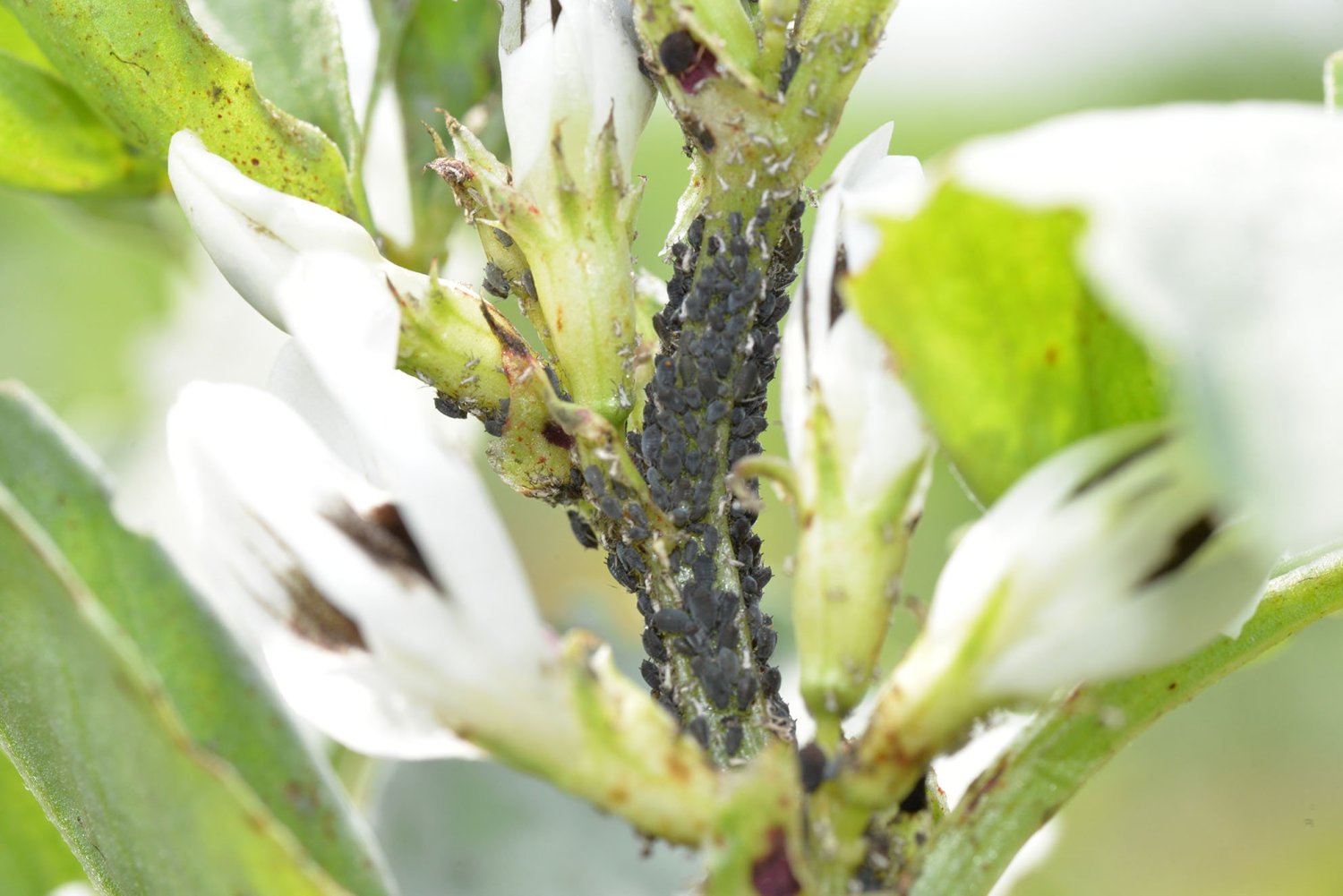 Black bean aphid colony on broad bean.
Black bean aphid colony on broad bean.
Peach potato aphid (Myzus persicae)
The peach potato aphid is 1-2 mm long, oval, and varies in colour from green to pale yellow and pink. Aphids are generally found on the underside of leaves and rarely form dense colonies. The main damage is caused by the transmission of viruses rather than direct feeding damage. The winter host is peach or nectarines, and they can overwinter in the mobile stage on a wide range of other plants. Winged aphids appear from May and when crowded, the aphids disperse to neighbouring plants, spreading any viruses which they carry. They have multiple summer hosts including peas, sugar beet and brassicas and in late summer winged forms can migrate to crops of winter oilseed rape. Peach potato aphid is a major crop pest, transmitting more than 120 plant viruses. A large proportion of M. persicae are now resistant to pirimicarb (MACE) and pyrethroid insecticides (KDR). There is no known resistance to neonicotinoid insecticides in the UK (Bayer Crop Science).
VIRUSES
There are several viruses that affect peas and beans, and key ones are listed below with symptoms and likely crop impact.
Pea seed-borne mosaic virus (PSbMV)
PSbMV is a non-persistently transmitted virus in peas that leads to high yield losses in some cases. The virus is primarily seed-borne but is transmitted by several aphids including the pea aphid, black bean aphid and peach-potato aphid. The virus becomes established after using infected seed and is transmitted by winged aphids early in the spring. Symptoms include vein-clearing, narrowing and downward rolling of leaflets and foreshortening of the apical internodes. Pods at the upper part of the plants may be stunted and appear to have a glossy green appearance. As the peas mature inside the pod a white blistering may develop giving the peas a ‘tennis-ball’ marking over the seed coat.
The virus affects quality in vining peas, and it is important to maintain disease-free seed stocks. PSbMV can be detected in seed using an ELISA (enzyme linked immunosorbent assay) test, although not all infected seeds give rise to infected seedlings.
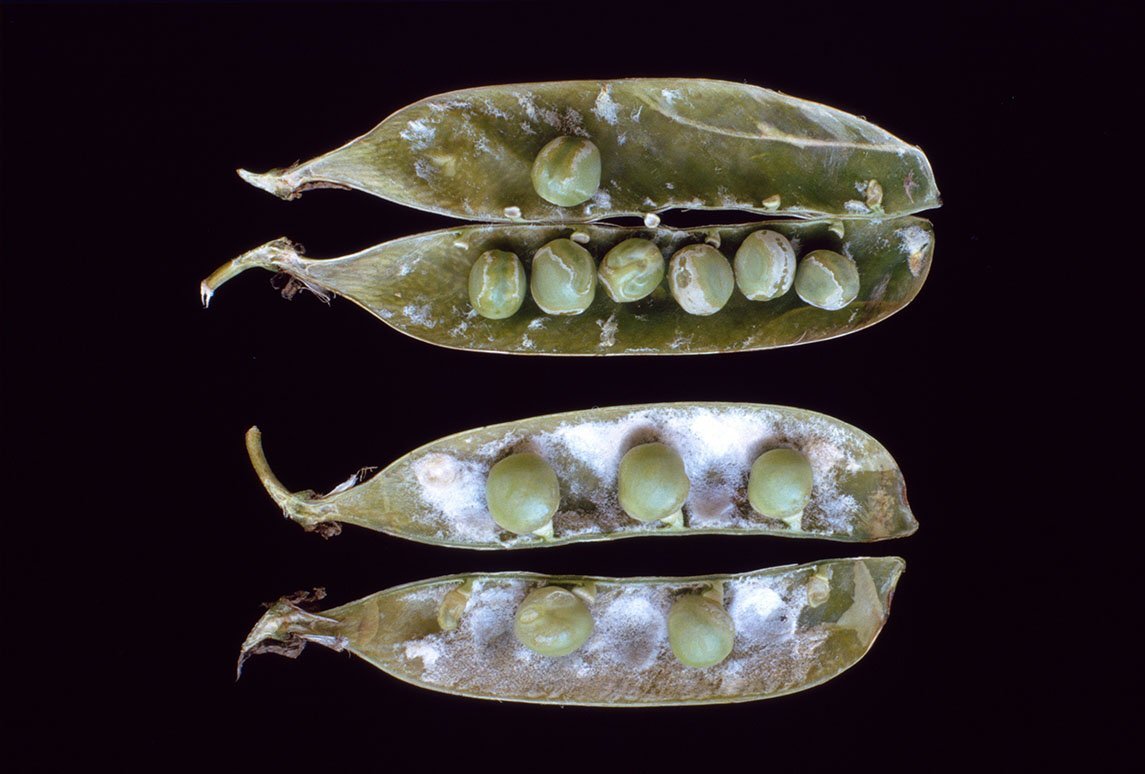 Typical Pea Seedborne Mosaic Virus symptoms on the seed.
Typical Pea Seedborne Mosaic Virus symptoms on the seed.
Pea enation mosaic virus (PEMV)
PEMV is a persistently transmitted virus, potentially leading to 30-50% yield loss in peas and field beans. The presence of this disease is seldom noticed before the approach of flowering, and often not until much later. PEMV is transmitted by aphids and is likely to have a greater effect on the crop if transmitted before flowering occurs. PEMV causes vein clearing and the formation of translucent spots which are apparent when infected leaves are held up to the light. Development of stipules is often retarded, and they remain very narrow. Leaflets are crinkled and necrotic spots may appear. Often the tops of the plants become yellow and mottled with distorted leaves. Pods may be severely malformed and fail to fill. The appearance of enations, small, irregular, protruding ridges of plant tissue which are found on the undersides of leaves and on pods, indicates an advanced stage of infection. Terminal growth ceases, axillary buds disappear, and flower set is impaired. In severe cases yield is greatly reduced. The upper leaves of field bean plants may become pointed and crinkled. Vein clearing can develop, and translucent spotting may appear. Individual plants or small groups of plants can show symptoms from late flowering onwards. Pea aphids are the most common vectors in field beans. Control of aphids when they first move into crops is likely to prevent serious infection with PEMV.
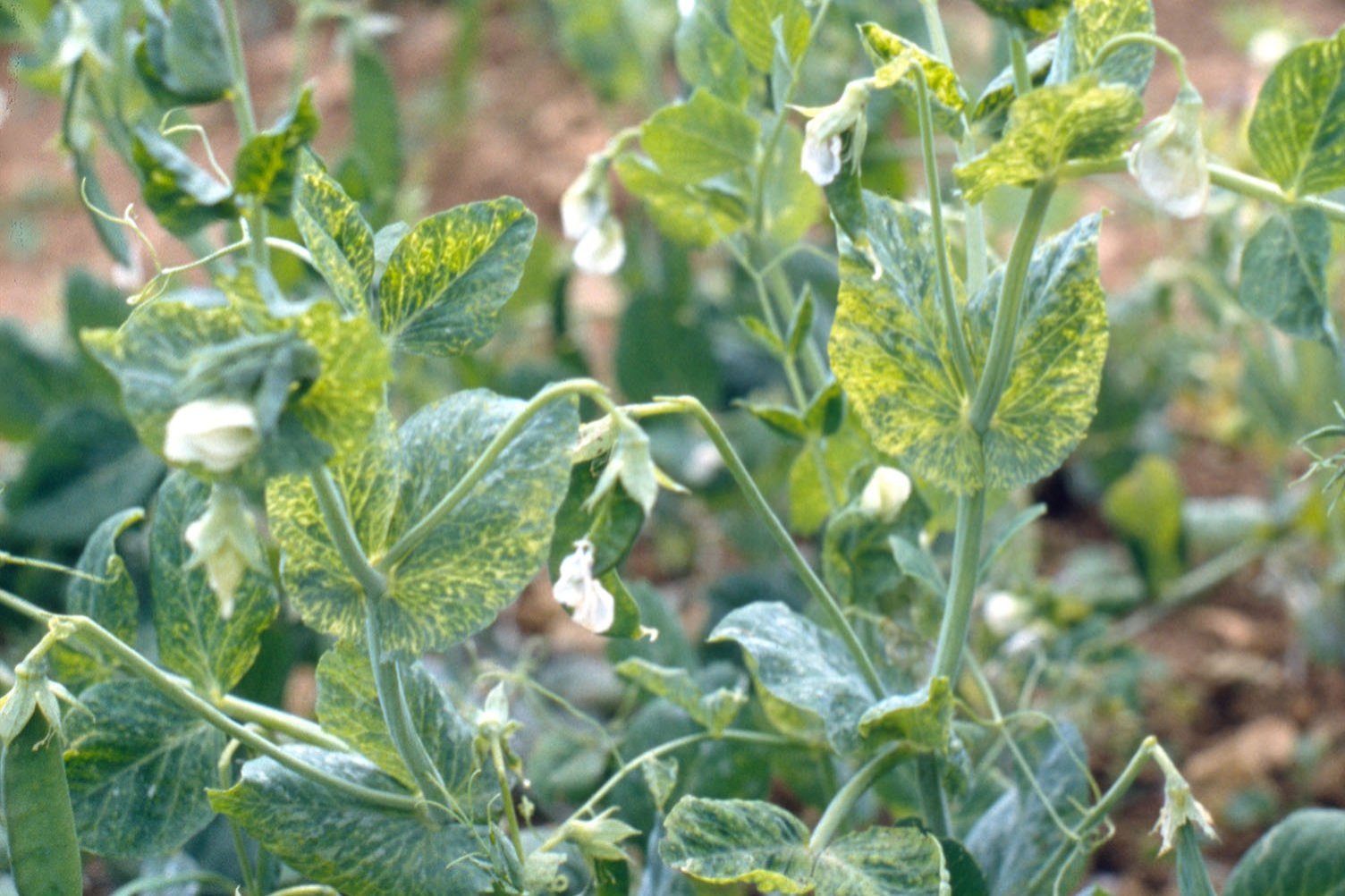 Typical Pea Enation Mosaic Virous symptoms.
Typical Pea Enation Mosaic Virous symptoms.
Turnip Yellows Virus (TuYV)
Turnip yellows virus, a persistent, aphid transmitted virus, is known to be present in the UK and causes high yield loss in oil seed rape. This was the most prevalent virus found in a survey of pea crops between 2019 and 2022 (AHDB, FV459). It has been reported in peas in Germany and Australia and has a wide host range, including brassicas and legumes. Stunting and yellowing have been previously associated with TuYV infection in peas, however yield loss studies on TuYV have not observed symptoms associated with TuYV infection. Despite lack of symptoms, up to 40% yield loss has been reported. The work conducted between 2019 and 2022 indicated that existing farm practice for control of aphid vectors mitigated the yield impact of TuYV in peas. TuYV is persistently transmitted by aphids, and it is not known to be transmitted by seeds or mechanically. The current resistance status of pea varieties in the UK is not known. It is not known whether TuYV is present in field beans.
Bean leaf roll virus (BLRV)
BLRV is a persistent, aphid-transmitted virus, leading to potential yield losses of between 50 and 90% in field beans when infection level is high. Both the black bean aphid and pea aphid are vectors. Infection is usually more obvious where aphids infest the crop before flowering.
Bean yellow mosaic virus (BYMV)
BYMV, a non-persistently transmitted virus, develops in field beans at any time before flowering. Leaves are crinkled and may become pointed. Vein clearing can develop, and the plant is slightly stunted. It is similar to PEMV but without the translucent spotting and streaking on the leaf surface. The virus is aphid transmitted and common in field beans. Infection may be on individual plants or groups of plants and, depending on severity, yield can be severely reduced. Pea aphid is the principal vector, although black bean aphid can also transmit the virus.
Table 1: Legume viruses, vectors (or mode of transmission) and host plant species. P = persistent. NP = non-persistent.
|
Virus |
Vector/ mode of transmission |
Reported host plants (for virus) |
|
Bean leaf roll virus (BLRV) (P) |
pea aphid and peach-potato aphid |
faba beans, peas, lucerne, red clover, sainfoin, and white clover |
|
Bean yellow mosaic virus (BYMV) (NP) |
pea aphid, peach potato aphid and black bean aphid (sometimes seed-borne) |
chickpeas, faba beans, peas, lentils, lupins, lathyrus, lucerne, vetch, medic and clover |
|
Broad bean true mosaic virus (BBTMV) |
pea and bean weevil, clover seed weevil, seed-borne |
faba beans |
|
Pea enation mosaic virus (PEMV) (P) |
pea aphid, potato aphid, peach potato aphid |
peas, lucerne, faba beans and vetches |
|
Pea early browning virus (PEBV) (P) |
stubby root nematodes, seed-borne |
peas, lupins, black medic, lucerne, Phaseolus beans and faba beans |
|
Pea seed-borne mosaic virus (PSbMV) (NP) |
seed-borne, pea aphid, peach potato aphid, black bean aphid |
peas, chickpeas, lentils, shepherds purse and faba beans |
|
Turnip yellows virus (TuYV) (P) |
pea aphid, peach potato aphid |
brassicas, radish, peas, clover, chickpea, lupin, vetch, faba bean, multiple weed species |
INTEGRATED PEST MANAGEMENT
Prevention:
Although more research is required to evaluate the effect of different rotations on aphid populations and virus risk, it is advisable to avoid planting peas and beans adjacent to crops that are susceptible to colonisation by pea, black bean or peach potato aphids and from which viruses that infect peas and beans may be transmitted. Avoid following crops where other host species have been present, including SFI and CS options.
Monitoring and decision support:
The Rothamsted Insect Survey (https://insectsurvey.com/aphid-bulletin) provides information about aphid flights throughout the season and is a useful tool to help predict activity in crops. Generally speaking, when aphid flights are first recorded in Insect Survey suction traps, aphids will be present in crops a few days later. PGRO recommends that growers use the information from the Rothamsted Insect Survey to help predict movement into crops.
Careful in-field inspection can identify the presence of aphids at low numbers. Growers and advisors should examine plants, turning leaves to inspect the undersides. Early aphids may not be easily visible, especially pea aphids, as they may colonise the undersides of pea and bean leaves first. When aphids colonise at early growth stages, damage to crop performance due to virus transmission is generally more severe, hence the importance of early identification.
Cultural control:
Mixed flowering field margins:
There are multiple sources that report the beneficial effects of flowering field margins to provide Integrated Pest Management services relating to aphids. Wackers et al. (2014) reported that aphid numbers in peas were lower in areas of crops adjacent to perennial flowering field margins. This was due to the encouragement of visitation by certain groups of beneficial insects, including pest predators and natural enemies, leading to increased parasitisation of aphid species in crops. In some instances, this led to yield increases in peas. Further work conducted by PGRO in 2023 indicated that this was true in field beans where mixed flowering field margins led to a reduction in aphid numbers adjacent to the margin, and an increase in yield related to aphid numbers. Benefits provided by flowering field margins are considered to be a result of natural enemy diversity, including parasitoids, specialist predators such as hoverflies, and generalist predators such as carabid beetles and spiders, as well as the enhancement of early season activity of parasitoids and carabid beetles. Data has shown that flowering field margins can play an important role in promoting these two factors (Powell et al., 2004). Floral field margins are associated with a significant increase in abundances and species diversity of natural enemies of crop pests, as well as a significant decrease in pest abundance and crop damage (Crowther et al., 2023).
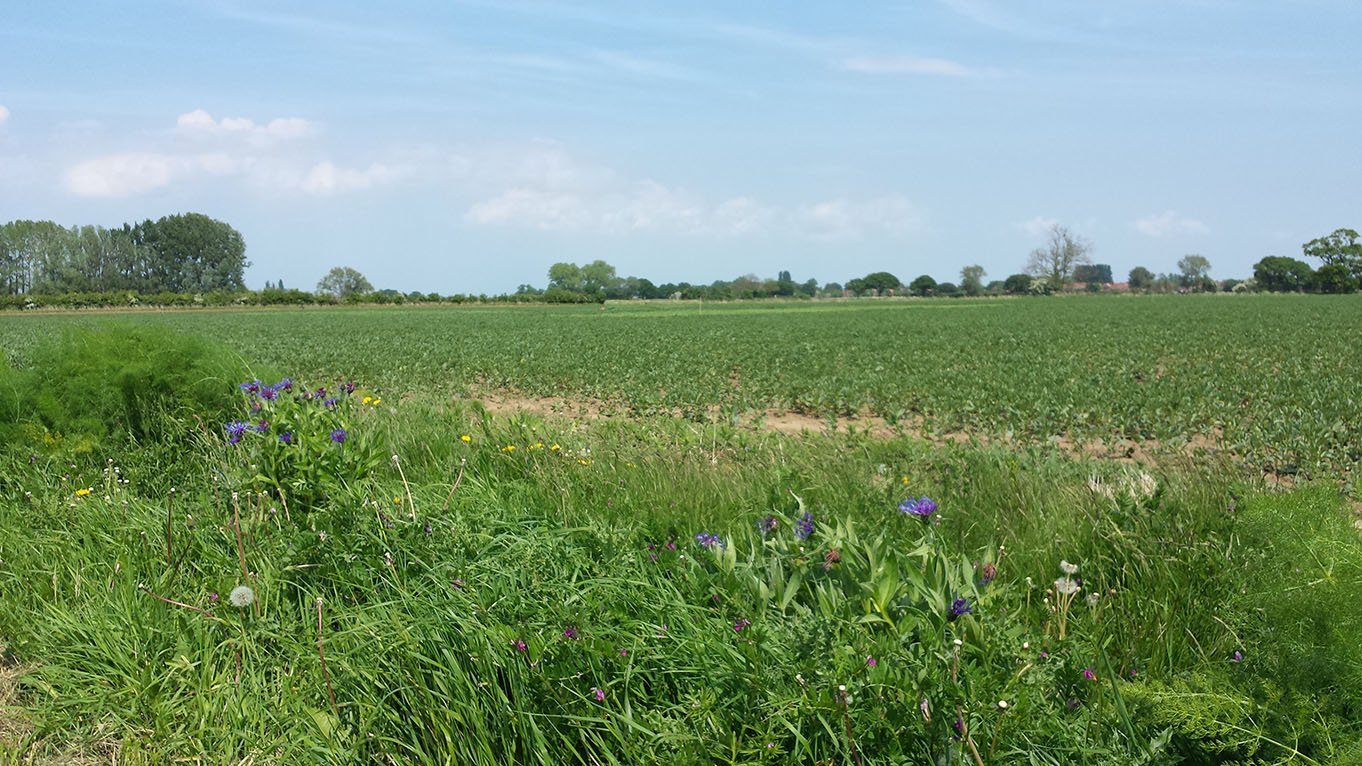 Aphid flowering margin at STC.
Aphid flowering margin at STC.
Varietal resistance:
Resistance or tolerance to viruses may be present in some cultivars and breeders may be contacted for further information. The use of tolerant or resistant varieties can help to reduce yield loss.
Intercropping or companion cropping:
Intercropping may reduce pest pressure when compared to monocultures, restricting pest colonisation by impeding foraging, visually camouflaging crops, and masking host plant odours that allow pests to locate their host. Intercrops can also enhance control by providing conditions that attract and sustain natural enemies. Canopy structure and below ground variation provided by intercrops can help to reduce the impact of extreme weather, and increase organic matter content, allowing beneficial insects and natural enemies to survive and overwinter more easily (Huss et al., 2022).
Seed testing:
Seed testing for PSbMV is the principal means to prevent virus infection in crops. The virus is non-persistent and therefore difficult to manage using insecticides when present in crops.
Pest avoidance:
Sowing date of peas and beans may be adjusted to avoid peak aphid activity, preventing transmission of viruses when plants are at early growth stages, and lowering the risk of damaging virus infections. This is likely to be most effective when sowing date is early, or when early maturing varieties are used, as mature plants are reported to be more resistant to viruses.
The removal of other hosts, especially weeds, will reduce primary inoculum sources.
Biotechnical
The following biological and non-pesticide products are available in peas and beans to control aphids.
|
Product |
Active substance |
Notes |
Crop |
|
Aphipar-M |
Aphidius matricariae |
Parasitic wasp |
Peas, field beans, all edible outdoor crops |
|
Agri 50 E |
Dodecylphenol ethoxylate |
Non-ionic surfactant, Physical-acting |
Peas, field beans, all edible and non-edible crops |
|
SB Plant Invigorator |
|
Physical control |
Peas, field beans |
|
Flipper |
Fatty acids C7-C20 |
Physical control |
Vining peas, broad beans, French beans, runner beans, edible podded peas |
Thresholds for chemical control:
Economic thresholds may vary depending on the value of the crop and cost of control. Where virus management is required, insecticides should be applied when aphids are first observed.
Black bean aphids are relatively easy to control using aphicide sprays, but because the beans are often flowering, the choice of aphicides is limited to those which will not harm pollinating insects. Colonies first develop on headlands, but where a general infestation of 10% of plants are colonised, spraying should be carried out as soon as possible. Applications made at early flowering or when 5% of plants are infested reduce infections of aphid-transmitted viruses.
Losses in peas due to pea aphids can be varied and significant. If there is a light but general distribution in humid weather, or if breeding colonies are evident, then control measures are generally warranted. The thresholds for chemical treatment of pea aphid to prevent feeding damage are as follows: spray combining peas when 20% of plants are infested and vining peas when 15% of plants are infested. Where virus management is required, insecticides should be applied when aphids are first observed. Always check labels for harvest intervals. The choice of product should be made with consideration of any other pests that are present at the time, such as pea midge and pea moth.
Chemical:
Some persistent viruses may be managed by careful use of aphicides at the earliest growth stage approved. In pulses (combining peas and field beans), there are no completely effective products available for use before the enclosed bud stage, and therefore virus risk may be greater in years when aphids are invading crops at earlier growth stages. Pyrethroids, while approved at earlier growth stages, may not give complete control of aphids in peas and beans. In some vegetable legumes, it is possible to apply flonicamid, an effective aphicide, from the two to three leaf-pair stage, and therefore virus management may be more effective in these crops. In the case of pea seed-borne mosaic virus and pea enation mosaic virus, aphids should be controlled as soon as colonies appear, particularly if this occurs before flowering. Where aphid infestation occurs late in the growing season yield increases from aphicides such as acetamiprid or pirimicarb can be obtained in combining peas up to the development of the fourth pod-bearing node. Where infestation occurs after this point there is no appreciable yield loss.
References:
Crowther, L., Wilson, K. and Wilby, A. (2023). The impact of field margins on biological pest control: a meta-analysis. BioControl 68:387–396. https://doi.org/10.1007/s10526-023-10205-6
Huss, C.P., Holmes, K.D. and Blubaugh C.K. (2022). Benefits and Risks of Intercropping for Crop Resilience and Pest Management. Journal of Economic Entomology, 115(5), 1350–1362. https://doi.org/10.1093/jee/toac045.
Powell, W., A’Hara, S.A., Harling, R., Holland, J.M., Northing, P., Thomas, S.F.G., and Walters, K.F.A. (2004). Managing biodiversity in field margins to enhance integrated pest control in arable crops (‘3-D Farming’ Project). HGCA PROJECT REPORT NO. 356. https://ahdb.org.uk/managing-biodiversity-in-field-margins-to-enhance-integrated-pest-control-in-arable-crops-3-d-farming-project.
Wackers, F., Croft, P., Wakefield, M. and George, D. (2014). Perennial field margins with combined agronomical and ecological benefits for vegetable rotation schemes. HDC PROJECT REPORT FV 334. https://horticulture.ahdb.org.uk/fv-334-perennial-field-margins-with-combined-agronomical-and-ecological-benefits-for-vegetable-rotation-schemes.
Bayer Crop Science Agronomy ID: Peach Potato Aphid (bayer.co.uk)
PGRO Pulse Agronomy Guide (2024). https://www.pgro.org/pulse-agronomy-guide/
For more information about virus management, please contact PGRO in 01780 782585.